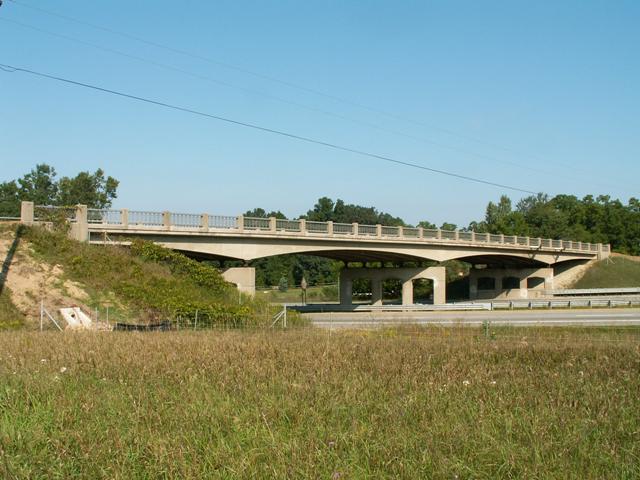We Recommend:
Bach Steel - Experts at historic truss bridge restoration.
BridgeHunter.com Phase 1 is released to the public! - Visit Now
6th Street Bridge

Primary Photographer(s): Nathan Holth
Bridge Documented: September 26, 2006
Rural: Kalamazoo County, Michigan: United States
1960 By Builder/Contractor: Canonie Construction Company of South Haven, Michigan and Engineer/Design: Michigan State Highway Department
2006
79.7 Feet (24.3 Meters)
257.0 Feet (78.3 Meters)
26.2 Feet (7.99 Meters)
4 Main Span(s)
39139024000S020

View Information About HSR Ratings
Bridge Documentation
View Archived National Bridge Inventory Report - Has Additional Details and Evaluation
This bridge is similar to the nearby 4th Street Bridge. On this page for the 6th Street Bridge however a more thorough narrative is available that not only discusses the 6th Street Bridge but also discusses both of these bridges as a whole.
A photo-documentation of these bridges on Labor Day of 2006 was not a moment too soon. A repair project had been underway, and at that time all repair work had been completed for both bridges, with the only thing remaining being the addition of modern Armco guardrails, which make the bridge less attractive and damage the historic integrity, although not as much as removing them completely, as has unfortunately been done elsewhere. The 4th Street Bridge had new approach railings installed and even had some holes drilled into the original guardrail posts to screw the new railings in. 6th Street offered a different unique opportunity that day however. While construction work on the bridge itself had been done, modern railings had neither been installed on the bridge itself, nor even on the approach railings. The bridge was still closed to traffic for repair as such. This offered a unique opportunity to photo the bridge with unprecedented historic integrity. While a few of these bridges retain integrity in that modern railings have not been added to the bridge itself, you will not find an expressway overpass without modern guardrails at least leading up to the bridge on the approach. This was a unique opportunity on the 6th Street Bridge made possible only by the repair project, which included removing the old approach guardrails. When this bridge was first built, there may have been approach railings, but they were likely steel cable railings which would not be as readily visible.
Although among the newer bridges featured on this website, Michigan's special curved t-beam overpass design featured a very aesthetically pleasing design, which is derived from the graceful design of the arched beams alongside the standardized, yet detailed railing design of the period. These bridges are a rare case where an expressway bridge has aesthetic value. There are a number of this curved t-beam bridge type remaining in Michigan, mostly on I-94, but only a few still remain with no modifications to the railings. Sigler Road is one of the oldest. As such, each example that remains without modern railings is historically significant in my opinion.
What should MDOT have done instead when they repaired this bridge? First off, it is debatable as to how badly these bridges really needed added railings. There is an elevated sidewalk-like portion of the deck that acts like a concrete curb, which helps to keep cars from ever even reaching the railings. There has been no damage to the railings of both the 4th and 6th Street Bridges over the 50 years of serving vehicular traffic. However, if railings did need to be added, there are other safe railings that do not block off as much visually. Those seen on Maple Road Bridge are one such example. While these would still affect integrity, they would not create the solid wall that the currently added railings show.
This bridge is tagged with the following special condition(s): Unorganized Photos
![]()
Photo Galleries and Videos: 6th Street Bridge
Bridge Photo-Documentation
A collection of overview and detail photos. This photo gallery contains a combination of Original Size photos and Mobile Optimized photos in a touch-friendly popup viewer.Alternatively, Browse Without Using Viewer
![]()
Additional Unorganized Photos
Original / Full Size PhotosThis photo gallery features older ca. 2003-2006 photos taken when the website only included a few photos in original size on the website, and a smaller quantity of reduced size photos as well. This unorganized gallery may partially duplicate photos in other galleries on this bridge's page, however all photos here are available in the Original / Full Size. This gallery offers photos in the highest available resolution and file size in a touch-friendly popup viewer.
Alternatively, Browse Without Using Viewer
![]()
Additional Unorganized Photos
Mobile Optimized PhotosThis photo gallery features older ca. 2003-2006 photos taken when the website only included a few photos in original size on the website, and a smaller quantity of reduced size photos as well. This unorganized gallery may partially duplicate photos in other galleries on this bridge's page, however all photos here are available in the Original / Full Size. This gallery features data-friendly, fast-loading photos in a touch-friendly popup viewer.
Alternatively, Browse Without Using Viewer
![]()
Maps and Links: 6th Street Bridge
Coordinates (Latitude, Longitude):
Search For Additional Bridge Listings:
Bridgehunter.com: View listed bridges within 0.5 miles (0.8 kilometers) of this bridge.
Bridgehunter.com: View listed bridges within 10 miles (16 kilometers) of this bridge.
Additional Maps:
Google Streetview (If Available)
GeoHack (Additional Links and Coordinates)
Apple Maps (Via DuckDuckGo Search)
Apple Maps (Apple devices only)
Android: Open Location In Your Map or GPS App
Flickr Gallery (Find Nearby Photos)
Wikimedia Commons (Find Nearby Photos)
Directions Via Sygic For Android
Directions Via Sygic For iOS and Android Dolphin Browser
USGS National Map (United States Only)
Historical USGS Topo Maps (United States Only)
Historic Aerials (United States Only)
CalTopo Maps (United States Only)

